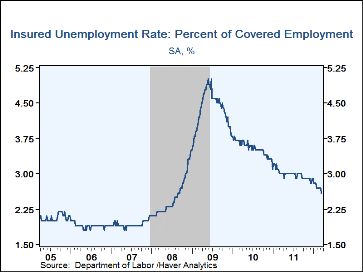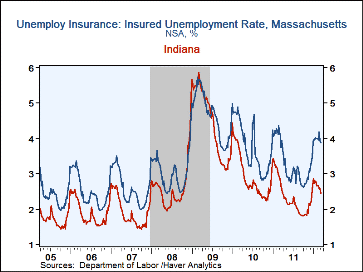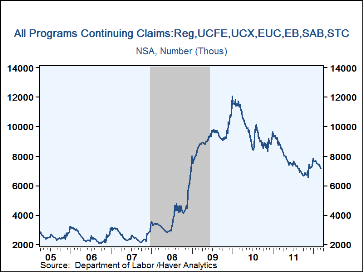 Global| Mar 29 2012
Global| Mar 29 2012U.S. Initial Claims for Jobless Insurance Continue Downward
by:Tom Moeller
|in:Economy in Brief
Summary
The job market continued to firm last week. Initial claims for unemployment insurance fell 5,000 to 359,000 during the week ended March 24 from an upwardly revised 364,000 in the previous week. The latest figure was the lowest since [...]
The job market continued to firm last week. Initial claims for unemployment insurance fell 5,000 to 359,000 during the week ended March 24 from an upwardly revised 364,000 in the previous week. The latest figure was the lowest since April of 2008 and data back to 2007 were revised due to updated seasonal factors. The weekly number compared to Consensus expectations for 350,000 claims. Continuing downward was the four-week moving average of initial claims to the cycle's low of 365,000. During the last ten years there has been a 74% correlation between the level of claims and the m/m change in nonfarm payrolls.
Continuing claims for unemployment insurance fell to 3.340M during the week of March 17, their lowest since August 2008. The insured rate of unemployment fell to 2.6%, also the lowest since August 2008. This particular count covers only "regular" programs and does not include all extended benefit and other specialized jobless insurance programs. In the week of March 10, the latest figure available, the grand total of all benefit recipients fell to 7.153M (-16.4% y/y).
By state, the insured unemployment rate varied greatly with Virginia (1.6%), Texas (1.6%), Florida (1.8%), Louisiana (2.0%), Arizona (2.2%), Tennessee (2.2%), and Indiana (2.5%) at the low end of the range. At the high end were rates in New York (3.5%), Illinois (4.0%), Massachusetts (3.9%), California (3.9% ), Michigan (4.0%), New Jersey (4.2%), and Pennsylvania (4.6%).
Data on weekly unemployment insurance programs are contained in Haver's WEEKLY database, including the seasonal factor series, and they are summarized monthly in USECON. Data for individual states, including the unemployment rates that determine individual state eligibility for the extended benefits programs and specific "tiers" of the emergency program, are in REGIONW, a database of weekly data for states and various regional divisions. Action Economics consensus estimates are in AS1REPNA.
The Availability and Profitability of Credit Cards from the Federal Reserve Bank of Cleveland can be found here.
| Unemployment Insurance (000s) | 03/24/12 | 03/17/12 | 03/10/12 | Y/Y% | 2011 | 2010 | 2009 |
|---|---|---|---|---|---|---|---|
| Initial Claims | 359 | 364 | 363 | -10.5 | 409 | 459 | 574 |
| Continuing Claims | -- | 3,340 | 3,381 | -11.4 | 3,745 | 4,544 | 5,807 |
| Insured Unemployment Rate (%) | -- | 2.6 | 2.7 | 3.0 (3/11) |
3.0 | 3.6 | 4.4 |
| Total "All Programs" (NSA) | -- | 3.153M | -18.4 | 2.750M | 9.850M | 9.163M |
Tom Moeller
AuthorMore in Author Profile »Prior to joining Haver Analytics in 2000, Mr. Moeller worked as the Economist at Chancellor Capital Management from 1985 to 1999. There, he developed comprehensive economic forecasts and interpreted economic data for equity and fixed income portfolio managers. Also at Chancellor, Mr. Moeller worked as an equity analyst and was responsible for researching and rating companies in the economically sensitive automobile and housing industries for investment in Chancellor’s equity portfolio. Prior to joining Chancellor, Mr. Moeller was an Economist at Citibank from 1979 to 1984. He also analyzed pricing behavior in the metals industry for the Council on Wage and Price Stability in Washington, D.C. In 1999, Mr. Moeller received the award for most accurate forecast from the Forecasters' Club of New York. From 1990 to 1992 he was President of the New York Association for Business Economists. Mr. Moeller earned an M.B.A. in Finance from Fordham University, where he graduated in 1987. He holds a Bachelor of Arts in Economics from George Washington University.










